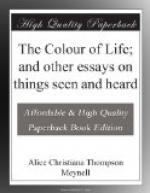THE HONOURS OF MORTALITY
The brilliant talent which has quite lately and quite suddenly arisen, to devote itself to the use of the day or of the week, in illustrated papers—the enormous production of art in black and white—is assuredly a confession that the Honours of Mortality are worth working for. Fifty years ago, men worked for the honours of immortality; these were the commonplace of their ambition; they declined to attend to the beauty of things of use that were destined to be broken and worn out, and they looked forward to surviving themselves by painting bad pictures; so that what to do with their bad pictures in addition to our own has become the problem of the nation and of the householder alike. To-day men have began to learn that their sons will be grateful to them for few bequests. Art consents at last to work upon the tissue and the china that are doomed to the natural and necessary end—destruction; and art shows a most dignified alacrity to do her best, daily, for the “process,” and for oblivion.
Doubtless this abandonment of hopes so large at once and so cheap costs the artist something; nay, it implies an acceptance of the inevitable that is not less than heroic. And the reward has been in the singular and manifest increase of vitality in this work which is done for so short a life. Fittingly indeed does life reward the acceptance of death, inasmuch as to die is to have been alive. There is a real circulation of blood-quick use, brief beauty, abolition, recreation. The honour of the day is for ever the honour of that day. It goes into the treasury of things that are honestly and—completely ended and done with. And when can so happy a thing be said of a lifeless oil-painting? Who of the wise would hesitate? To be honourable for one day—one named and dated day, separate from all other days of the ages—or to be for an unlimited time tedious?
AT MONASTERY GATES
No woman has ever crossed the inner threshold, or shall ever cross it, unless a queen, English or foreign, should claim her privilege. Therefore, if a woman records here the slighter things visible of the monastic life, it is only because she was not admitted to see more than beautiful courtesy and friendliness were able to show her in guest-house and garden.
The Monastery is of fresh-looking Gothic, by Pugin—the first of the dynasty: it is reached by the white roads of a limestone country, and backed by a young plantation, and it gathers its group of buildings in a cleft high up among the hills of Wales. The brown habit is this, and these are the sandals, that come and go by hills of finer, sharper, and loftier line, edging the dusk and dawn of an Umbrian sky. Just such a Via Crucis climbs the height above Orta, and from the foot of its final crucifix you can see the sunrise touch the top of Monte Rosa, while the encircled lake below is cool with the last of the night. The same order of friars keep that sub-Alpine Monte Sacro, and the same have set the Kreuzberg beyond Bonn with the same steep path by the same fourteen chapels, facing the Seven Mountains and the Rhine.




